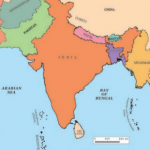Class 6-Ch-8 Geography : India Climate, Vegetation & Wildlife
- Weather is about day to day changes in the atmosphere. It includes changes in temperature, rainfall and sunshine etc.
- However, the climate is about the average weather condition, which have been measured over many years.
- The major seasons recognised in India are:
- Cold Weather Season (Winter) : December to February– During this season, the sun rays do not fall directly in the region. As a result, the temperatures are quite low in northern India.
- Hot Weather Season (Summer): March to May – The sun rays more or less directly fall in this region. Temperature becomes very high. Hot and dry winds called loo, blow during the day.
- Southwest Monsoon Season (Rainy): June to September – It is marked by the onset and advance of monsoon. The winds blow from Arabian Sea and Bay of Bengal towards the land and carry moisture with them. When these winds strike the mountain barriers, rainfall occurs.
- Season of Retreating Monsoon (Autumn): October and November: Winds move back from the mainland to the Bay of Bengal. The southern parts of India, particularly Tamil Nadu and Andhra Pradesh receive rainfall in this season.
- The climate of India has broadly been described as Monsoon type.
- Due to India’s location in the tropical region, most of the rain is brought by monsoon winds.
- The climate of a place is affected by its location, altitude, distance from the sea, and relief.
Natural Vegetation
- The grasses, shrubs and trees, which grow on their own without interference or help from human beings are called natural vegetation.
- Different types of natural vegetation are dependent on different climatic conditions, among which the amount of rainfall is very important.
- Due to varied climatic conditions, India has a wide range of natural vegetation.
- Vegetation of India can be divided into five types:
- Tropical Evergreen Forests –
- They are also called tropical rain forests.
- They occur in the areas which receive heavy rainfall.
- They are so dense that sunlight doesn’t reach the ground.
- Many species of trees are found in these forests, which shed their leaves at different times of the year. Therefore, they always appear green and are called evergreen forest.
- Important trees: Mahogany, Ebony and Rosewood.
- Places where they occur: Andaman & Nicobar islands, parts of north-eastern states and a narrow strip of the western slope of the western ghats.
2. Tropical Deciduous Forests
- They are also called monsoon forests.
- They are widespread in India.
- They are less dense.
- They shed their leaves at a particular time of the year.
- Important trees: sal, teak, peepal, neem and shisham.
- Places where they occur: MP, UP, Bihar, Jharkhand, Chattisgarh, Odisha and in parts of Maharashtra
3. Thorny Bushes
- They are found in dry regions.
- The leaves are in the form of spines to reduce the loss of water.
- Important trees: Cactus, Khair, Babool, Keekar
- Places where they occur: Rajasthan, Punjab, Haryana, Eastern slopes of Western Ghats and Gujarat
4. Mountain Vegetation
- A wide range of species is found in the mountains according to the variation in height.
- At a height between 1500 metres and 2500 metres most of the trees are conical in shape. These trees are called coniferous trees.
- Important trees: Chir, Pine, Deodar
5. Mangrove Forests
- They can survive in saline water.
- Important trees: Sundari
- Places where they occur: They are found mainly in Sunderbans in West Bengal and in the Andaman & Nicobar Islands.
Wildlife
- Gir Forest in gujarat: Asiatic lions
- Assam: elephants & one-horned rhinoceroses
- Kerala & Karnataka: Elephants
- Great Indian Desert: Camels
- Rann of Kuchchh: Wild Ass
- Himalayas: Wild goats, snow leopards, bears etc
- In order to protect wildlife many national parks, sanctuaries and biosphere reserves have been set up.
- The government has also started Project Tiger and Project Elephant to protect these animals.
- Wildlife week is celebrated in the first week of October, to create awareness of conserving the habitats of animals.
















